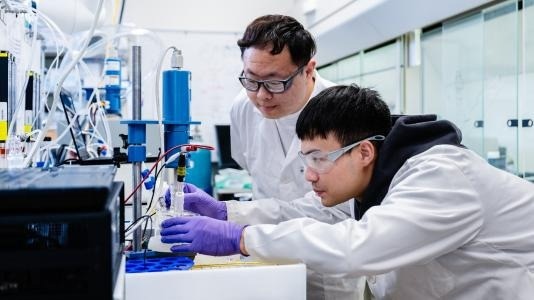In a collaborative effort involving the US Department of Energy’s (DOE) Argonne National Laboratory, Northern Illinois University, and Valparaiso University, scientists have unveiled a family of catalysts capable of efficiently converting CO2 into ethanol, acetic acid, or formic acid. The study was published in the Journal of the American Chemical Society.
 Researchers experimented with tin-based catalysts that efficiently convert CO2 into ethanol, acetic acid, or formic acid. Shown in the image are Argonne researchers Haozhe Zhang and Jianxin Wang. Image Credit: Argonne National Laboratory.
Researchers experimented with tin-based catalysts that efficiently convert CO2 into ethanol, acetic acid, or formic acid. Shown in the image are Argonne researchers Haozhe Zhang and Jianxin Wang. Image Credit: Argonne National Laboratory.
Hidden within the emissions of numerous industrial processes lies an overlooked resource: carbon dioxide (CO2). Viewed as a contributor to greenhouse gas emissions and global warming, it possesses the potential to be captured and transformed into valuable chemicals, thus offering an opportunity for sustainable utilization.
Liquid hydrocarbons are among the most commonly produced chemicals in the US and are integral to numerous commercial products. Ethanol, for instance, is a crucial ingredient in various household items and is added to nearly all gasoline distributed in the US.
The catalysts are based on tin metal deposited over a carbon support.
If fully developed, our catalysts could convert the CO2 produced at various industrial sources to valuable chemicals. These sources include fossil fuel power plants and bio-fermentation and waste treatment facilities.
Di-Jia Liu, Senior Chemist, Argonne National Laboratory
Liu is also a senior scientist at the Pritzker School of Molecular Engineering at the University of Chicago.
The team employed electrocatalytic conversion, a method where electricity stimulates CO2 conversion over a catalyst. By adjusting the size of tin particles, ranging from single atoms to ultrasmall clusters and larger nano-crystallites, the team managed to regulate the conversion of CO2 into acetic acid, ethanol, and formic acid, respectively. Remarkably, the selectivity for each of these chemicals exceeded 90%.
“Our finding of a changing reaction path by the catalyst size is unprecedented,” Liu added.
Both computational and experimental studies unveiled numerous insights into the reaction mechanisms responsible for forming the three hydrocarbons.
One crucial revelation was the complete alteration of the reaction pathway when the conventional water used in the conversion was replaced with deuterated water (where deuterium, an isotope of hydrogen, is substituted for hydrogen). This phenomenon, known as the kinetic isotope effect, had never before been observed in CO2 conversion processes.
This research was facilitated by two DOE Office of Science user facilities at Argonne—the Advanced Photon Source (APS) and the Center for Nanoscale Materials (CNM).
Using the hard X-Ray beams available at the APS, we captured the chemical and electronic structures of the tin-based catalysts with different tin loadings.
Chengjun Sun, Physicist, Argonne National Laboratory
Furthermore, the high spatial resolution achievable with a transmission electron microscope at CNM enabled the direct imaging of the arrangement of tin atoms, ranging from single atoms to small clusters, across various catalyst loadings.
According to Liu, “Our ultimate goal is to use locally generated electricity from wind and solar to produce desired chemicals for local consumption.”
To implement the newly discovered catalysts, they would need to be integrated into a low-temperature electrolyzer for conducting the CO2 conversion process using electricity sourced from renewable energy. Low-temperature electrolyzers can function at or close to ambient temperature and pressure, enabling quick startup and shutdown to adapt to the intermittent nature of renewable energy sources. This technology is well-suited for fulfilling this objective.
If we can selectively produce only the chemicals in need near the site, we can help to cut down on CO2 transport and storage costs. It would truly be a win-win situation for local adopters of our technology.
Di-Jia Liu, Senior Chemist, Argonne National Laboratory
Apart from Di-Jia Liu and Chengjun Sun, the authors of the study include Haiping Xu, Jianxin Wang, Haiying He, Inhui Hwang, Yuzi Liu, Haozhe Zhang, Tao Li, John V. Muntean, and Tao Xu.
The research received support from the DOE’s Office of Energy Efficiency and Renewable Energy through the Advanced Manufacturing Office and the Industrial Efficiency & Decarbonization Office. Further support was extended by Argonne’s Laboratory Directed Research and Development fund.
Journal Reference:
Xu, H., et al. (2024). Modulating CO2 Electrocatalytic Conversion to the Organics Pathway by the Catalytic Site Dimension. Journal of the American Chemical Society. doi.org/10.1021/jacs.3c12722.